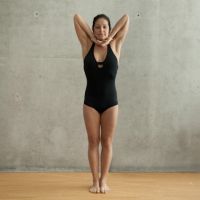Standing Deep Breathing Pose – Instructions
The Standing Deep Breathing Pose is the first posture performed during any Bikram Yoga session, before the main 26 postures. It’s original name is Pranayama, which means “an extension of your breathing / life force.”
Purposes & Benefits
This pose is performed to help transfer as much oxygen to your muscles and organs as possible, to expand your lungs, and to help put your mind at ease as well as increase your focus for the upcoming exercises. It will also help get your heart pump your blood, sending it to all the parts of your body that will need it the most while performing your Yoga poses.
It’s important to note that the Standing Deep Breathing pose is just as important as any other posture in your session. Many beginners mistakenly assume that it’s not on par with the other postures, and that they can approach it with less focus and energy than when performing, say, the half-moon pose. This the wrong attitude: the Pranayama is the prelude; it’s the introduction. If you skip it, nothing after it will make as much sense, and you’ll lose a lot of the benefits that can be gained from the remaining poses.
Performing The Standing Deep Breathing Pose (Pranayama)
As this is the first pose you’ll be doing, make sure you are dressed for your training session and properly hydrated. Give your arms and chest a very gentle stretch, and then assume the position seen on the picture below:

- As you maintain this pose, breath in and exhale very slowly. What this does is it helps your lungs expand to their full capacity, which is more difficult to achieve if breathing and exhaling rapidly.
- Pay attention to your back alignment and make sure that it is straight at all times and that you aren’t bending backwards at the hips – a common mistake among beginners. If you face any trouble doing this, try to suck in your stomach a little bit by flexing your abdominal muscles. This will push your rib cage forward and make it far less likely for you to accidentally bend backwards.
- During the exhale phase, tilt your head back at the neck. Do not use your hands to push the head backwards; rather, let the hands follow along with the movement of the head. This should be a reasonable tilt – if you feel any strain in the neck, you are going too far.
- Pay careful attention to your shoulders – they should be aligned with your hips, while the hips should be protruding slightly forward. If you have trouble achieving this, squeeze your buttocks a little bit and it will become easier.
Tips on Performing The Pranayama
Keep these in mind:
- Exhale completely, to the point that there is no extra air left in your lungs. The goal is to get rid of all the carbon dioxide in your body – to cleanse yourself.
- Many beginners close their eyes while performing the Standing Deep Breathing Pose. Try to avoid that; this is not a meditation exercise, and you should remain in touch with your surroundings, your body alignment, posture, etc. Keeping your eyes open will help you achieve that.
- Feeling a little dizzy is quite normal when performing very deep and slow breathing exercises. This does not mean anything is wrong, just that you are performing the pose correctly. If it gets to the point where you feel like you are about to faint (highly unlikely), take a break and next time try slightly shallower breaths.
Standing Deep Breathing Pose (Pranayama) Video
The video below is a quick and easy way to learn how to perform the Bikram Yoga Pranayama pose. Use what you learn from the video in conjunction with what you’ve learned above, and you’ll master this posture in no time.